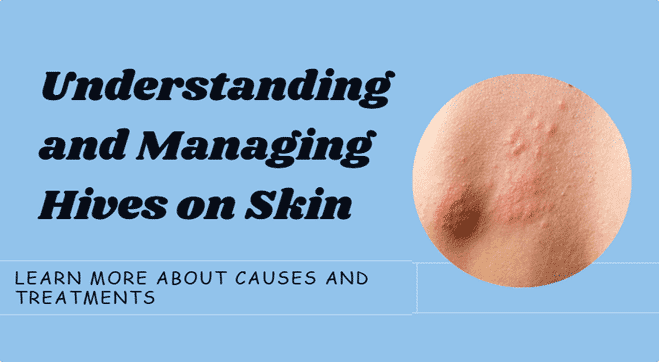Hives on the skin can be caused by a wide variety of factors. Some of these include exposure to certain allergens, such as those found in food items, use of particular types of drugs, and touching a surface that is already infected with allergy-causing agents.
While in most cases, the hives allergy goes away on its own in a few days, sometimes the severity of the hives allergic reaction can be high enough to require a hives rash treatment. Hence, it is important to understand the causes of hives, symptoms, and treatment options to keep yourself well protected from them.
Do you know:
- Medically termed Urticaria, hives on the skin (hives skin allergy or hives allergy) negatively affect approximately 15% to 20% of the global population at least once during the course of their whole lifetime.
- Among these, at least 30% of people continue suffering from the attack of hives from months to years. In these cases, either the hives allergy does not heal completely or keeps reoccurring (even after healing) after certain intervals.
- Women are more likely to suffer from skin allergy hives in comparison to men. 1
Hives On Skin: Definition, Types and Overview
Hives on the skin, generally called hives allergy, are skin rashes that appear as red-coloured, raised bumps (called welts). Skin allergy hives usually occur as an allergic reaction to some external irritant, which can range from touching a particular object to consuming a specific kind of edible material.
Characteristics Of Hives on Skin
Hives can produce one or more of the following markers on the skin, which can help you to identify them—
- Extreme itching
- Burning sensation
- Redness
- Swelling and inflammation
- Stinging sensation
Apart from these, when you have a hives allergy, the size of the bumps that are produced can vary from very small (as small as the size of your fingertip) to very large (as large as the size of a wall lock or a dinner plate)
3 Types Of Hives On Skin
Hives on the skin can be categorised into the following three types—
1. Acute Hives Allergy (Acute Urticaria)
Acute Hives are a mild to moderate condition that lasts less than 42 days (6 weeks) and does not produce overly dramatic hives symptoms.
2. Chronic Hives (Chronic Urticaria)
The causes of chronic hives usually remain hidden, and there is no apparent reason for their occurrence. These occur at least twice in 7 days and continue reoccurring for more than 42 days.
3. Physical Urticaria (Inducible Urticaria)
Factors like exposure to hot or cold weather conditions, as well as staying under the sun, can cause physical Urticaria, also called skin allergy hives.
It is important to note that the hives symptoms of physical Urticaria do not develop suddenly. They start being visible after 60 minutes of exposure to any of the above-mentioned factors.2
Common Causes of Hives
The use of certain medicines, the presence of a particular illness, and the intake of some food items that cause a hives allergic reaction in your body are the common causes of hives. However, the main causes of hives depend on the particular type of hives allergy that a person has.
So, depending on these, here is an overview of the factors that can cause different types of hives.
1. Acute Hives Causes
Acute hives can be caused by—
- Foods
- Medications
- Infections
- Insect bites
- Diseases
The foods that cause acute hives include—
- Nuts
- Chocolate
- Fish
- Tomatoes
- Egg
- Fresh berries
- Milk
- Food additives
- Preservatives are used to increase the lifespan of a food.
One interesting fact about acute hives allergies is that they are more often caused by fresh foods than cooked foods.
The medicines that cause acute hives include—
- NSAIDs (Non-Steroidal Anti-Inflammatory Drugs)
- Angiotensin-converting enzyme (ACE) Inhibitors (a medicine that is used to control high blood pressure)
- Ibuprofen
- Pain-relieving medicines like codeine
2. Chronic Hives Causes
Chronic hives can be caused by—
- Thyroid
- Hepatitis
- Infection
- Cancer
Remember that the main cause of chronic hives is usually very difficult to detect compared to the causes of acute hives.
3. Causes of Physical Urticaria or Allergic Reaction Hives Causes
Physical Urticaria is more commonly called skin allergy hives. These hives allergic reactions can be caused by—
- Exposure to cold, heat, and sunlight
- Sweating
- Exercising
- Vibrations
- Pressure
Recognising The Symptoms of Hives
The primary symptoms of hives include—
- Hives on the skin appear as welts or raised bumps that can be of various sizes.
- Red-coloured or reddish-coloured welts. These are difficult to identify in the case of people with a darker skin tone.
- The welts cause extreme itching, mostly during the night. Itching is one of the most troublesome symptoms of hives because it can make you lose sleep and hamper your overall quality of life within days.
It is important to note that these welts can appear and disappear even within minutes and hours, depending on a person’s individual situation and the main causes of hives.
Apart from this, hives on the skin can also cause swelling, which is known as angioedema. The hives symptoms associated with Angioedema include puffiness in the—
- Face
- Eyelid
- Ears
- Mouth
- Hands
- Feet
- Genitals
Other than these, the other hives symptoms that come along with Angioedema can include—
- Skin colour-related changes
- Pain and discomfort in the area which has the swelling
- Inflammation on only one side or a particular part of the body3
Hives Treatment Options
To get rid of hives due to allergies, several hives treatment options are available. These can range from the use of certain prescription and OTC (over-the-counter) medicines for hives relief to natural remedies for hives treatment.
So, here are some great remedies that you can use to treat hives:
1. Natural Remedies for Hives
The most beneficial natural remedies for hives treatment include the following—
1. 1. Cold Compression
Applying a cold compress to the hives on the skin can help to gradually bring down swelling and decrease irritation and itching due to allergies.
To do this, you simply have to grab some ice, wrap it in a towel, and apply it to the hives rash for not more than 10 minutes. To get a faster hive treatment, it is best to repeat this process a few times in the day until the skin allergy hives go away completely.
1.2. Anti-Itching Solution
The market has many varieties of anti-itching solutions that you can simply add to your bath water to get rid of itching that comes with hives allergy. Two of the best examples of such commonly available anti-itching solutions, which are highly effective for hives treatment, include—
- Baking soda
- Colloidal oatmeal
1.3. Witch hazel
Witch Hazel is another great home-based hives rash treatment because it can minimise irritation in case of skin allergy hives up to a great extent. However, for some people, it can result in contact dermatitis due to an allergic reaction to the product. That is why it is recommended to do a patch test on a small area of your skin before applying witch hazel directly to the hives on your skin.
Once you confirm that it does not cause an allergic reaction to your skin type, you can apply witch hazel as a mask a few times a day to treat hives. But do not let the mask sit on your skin for more than 20 minutes.
1.4. Aloe Vera Gel
Aloe vera gel is a natural anti-inflammatory ingredient that does not cause an allergic reaction in case of most people. However, it is still better to do a patch test before using it for hives rash treatment.
Following a patch test, either you can directly extract the aloe vera gel from a plant or buy a marketed preparation. After this, the aloe vera gel is applied to the affected area a few times every day to treat the hives on the skin.
2. Over-The-Counter (OTC) Medicines for Hives Treatment
One of the main causes of hives is the histamine response from your body when exposed to a particular allergen (for example, food, medicines, etc.). The over-the-counter drugs target this histamine response and inhibit it to help you get rid of hives.
So, here is a list of some over-the-counter (OTC) medicines that work well for hives on the skin—
- Calamine lotion: It needs to be applied directly on the target site of the hives allergy
- Diphenhydramine or Benadryl: This is an orally ingestible solution that reduces itching and rashes.
- Fexofenadine (Allegra)
- Loratadine (Claritin)
- Cetirizine (Zyrtec)
3. Prescription Drugs for Hives Rash Treatment
In cases where natural remedies for hives and over-the-counter medicines to treat hives symptoms do not work, it becomes essential to visit a doctor to get professional expertise.
Following a diagnosis, your doctor can recommend either of the following prescription-based medicines to help you get rid of hives symptoms—
- Prednisone or Deltasone: It is a type of corticosteroid that you can take orally.
- Omalizumab (Xolair): This medicine is usually injected under your skin in case of chronic hives treatment.
- Dapsone (Aczone): It is an antibiotic that is available in 2 forms: topical product and oral medicine.
- Leukotriene-Receptor Antagonists: It is a type of oral non-steroidal hives treatment drug.4
Preventing Hives: Tips For Managing Recurrences
When you are on your way to treating hives symptoms, using the right preventive and management methods can help you achieve a faster recovery and minimise the chances of the reoccurrence of hives on skin in the future.
Therefore, here is a list of some prevention and management tips for hives symptoms—
1. Regularly Apply Cold Compression During Hives Treatment
Be regular about the application of cold compression on the affected area where hives allergic reactions are present. For this, you can either wrap some ice cubes in a soft cotton cloth or dip a cloth in cold water and apply it directly to the affected area. Make sure that you repeat this process many times a day to get a quicker recovery from the hives on your skin.
2. Choose The Right Clothes
When there are hives on your skin, synthetic clothes that touch the affected area every now and then can make itching and irritation worse. This can lead to the worsening of your hive’s symptoms. That is why if you are getting the hives rash treatment, then it is a better idea to choose loose and lightweight clothes.
Along with this, it is equally important to choose a cool room for working and sleeping to get rid of hives.
When To See a Doctor to Get a Hives Treatment
If your hives symptoms stay for a longer than expected duration and keep on worsening, then seeing a doctor is a safer option. Likewise, certain hives symptoms indicate that you need to get an immediate professional hive treatment.
Here is a list of such alarming symptoms of hives
- Dizziness
- Facing difficulties with breathing normally
- Feeling a strange type of tightness in your chest
- Swelling in the face, tongue or lips
- Wheezing
Conclusion
All in all, while hives on the skin are a common problem, treating the symptoms of hives is not that difficult. Home remedies like cold compression, the application of aloe vera gel, and certain over-the-counter medicines can help you treat hives efficiently. However, the most important part is to recognise the type of hives allergy that you have and identify its underlying cause.








